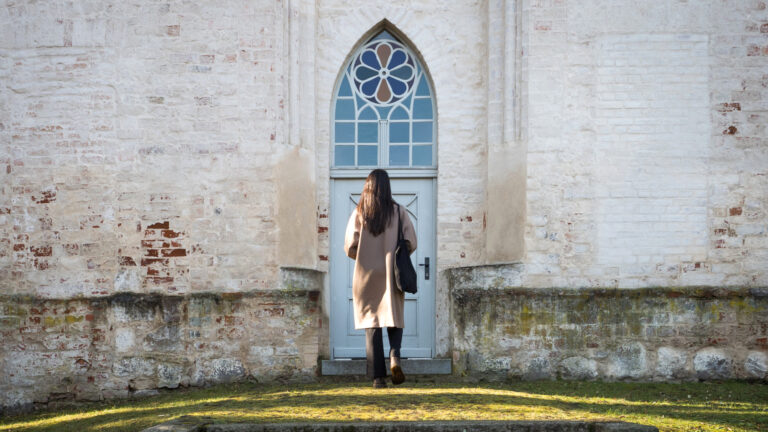In this episode of TGC Q&A, Chris Bruno and David Helm discuss the question, “What does Jesus look like? Is it okay to wonder?” They address:
- Where to start (:28)
- Overcoming the enculturated view (1:27)
- Why the Bible doesn’t tell us how Jesus looked (2:31)
- Whether or not it’s okay to create representations of Jesus (3:47)
- Should we depend on icons to further our worship? (6:12)
- Our desire to see God (7:13)
Explore more from TGC on this topic:
Transcript
The following is an uncorrected transcript generated by a transcription service. Before quoting in print, please check the corresponding audio for accuracy.
Chris Bruno: Well, the question of what Jesus looks like, in a way we can go a number of different directions on this. About 15 years ago or so popular mechanics put out this image of a 1st century Middle Eastern man. They did DNA testing, testing of bones fragments and things like that. And you’ll see it pop up on the internet every so often. If you’ve seen it, it’s just an average looking Middle Eastern man with a beard, dark hair, dark eyes, dark complected, all that sought of thing. So I guess we can start there and say, what did He look like? Well, He probably looked like that picture but that doesn’t give us much to go on.
David Helm: It’s nice the popular mechanics has given us a good run at it.
Chris Bruno: Yeah.
David Helm: I mean, He was born under the law, Galatians 4. We know He was Jewish. We know that there are particular facial features. I wasn’t aware that people have represented the common man of 1st century and the Lavant, I mean that’s nice to know. I grew up in the Evangelical Covenant Church and there was a Chicago artists last name Sallman who I believe in around 1940 did this famous portrait that earlier had been a pencil drawing. And from what I understand, it’s 500 million times reproduced. So I remember growing up with an idea of that’s what Jesus looked like. But I think social critical theory… All of a sudden people began to realize, “No, this is an inculturated view.” He didn’t have blue eyes. He wasn’t out of Norway. And… So yeah, you do have these questions. This question lingers in the mind of people. We are curious, what did He look like?
Chris Bruno: Yeah. And I think that explains a lot of those pictures. I think my grandmother had the same picture hanging up in her kitchen or something that I saw all my growing up years. The reality is that the Bible really never gives us a description of Jesus. It doesn’t describe that many people… At least in terms of their physical characteristics.
David Helm: Yeah. So it I’m with you on that. So what it does do is it wants us to know He shared our humanity. It doesn’t give us much about His facial features or His physical frame. We know John 20 or 19 He thirsted on the cross. “I thirst.” This common human feature. He wept, He has this… The Bible does want you to know He shares your humanity.
Chris Bruno: Yeah. I think that’s the important point to make. He’s like us in every way but without sin. So the Bible never says Jesus was five foot six and 150 pounds or He had dark hair or His beard was this long or His hair was this long. Although we get feature, He had a beard because they pulled on it. And then we can speculate about those things but it doesn’t seem that important in terms of what the picture of Jesus that the Bible is presenting to us. So let me ask you a question then.
David Helm: Yeah.
Chris Bruno: Is it okay for us to represent Jesus? You wrote a kid’s story Bible that my family has used a lot. And in there we have some representations of Jesus don’t we?
David Helm: Right. So let me take you back 18 years, we were working on a children’s Bible. It became the big picture story Bible. It’s going in around 25, 26 languages but one of the critiques has been, have you violated the second commandment? Have you in illustrative form depicted an image of Christ that the scriptures actually would have a steer clear of. And at first I wasn’t quite sure what to do with the critique but in regard to the question, what did he look like? All you got to think about Chris is church history, the humanist movement, art, the great masters, this depiction of, Mary, an infant, much of the art in the great art in the world has these depictions, but there’s an element within Christianity that would say none of that really should be done.
David Helm: So, you’ve got Oliver Cromwell leading the world and then later reform movements that would really be reticent to try to do that. But maybe what we ought to do is say the Bible’s concern isn’t with the image, Hebrews… We know He’s the exact icon the image of God.
Chris Bruno: Sure.
David Helm: But it’s with the idea. Image and idea. The idea is He represents us that in Him we see the fullness and glory of God, John 1, and that people did see Him.
Chris Bruno: Yeah. And in Him, the fullness of deity is contained bodily. And it’s hard for us to wrap our minds totally that, what that means. And I think you’re right that throughout church history… Even go back into the 7th, 8th century, there’s the iconic class controversy. People have been talking about this for centuries. And so… And that’s not even the main point of our questions, so maybe we can…
David Helm: But I think that’s maybe one area where I would probably think to have an icon that I am now asking myself to be led into further worship through the visualization of an image. That’s not something that I would probably advocate we ought to be going after.
Chris Bruno: Yeah. And that’s where I was going to go as well in that… It’s one question to ask, should we have an image of Jesus? It’s another question to say, should we picture a particular image of Jesus while we’re praying? Should we have it in our mind and focus our even veneration and worship towards that? That seems dangerous ground to move into. Because we’ve said that the Bible doesn’t give us a physical description of Jesus. So if we’re… If whether it’s from somebody else’s mind or our own imagination, we’re creating this physical depiction of Jesus that we’re then praying too. That strikes me as inching close to if not passing the line into idolatry.
David Helm: Yeah. I don’t have a problem with that conviction that you share. Recently, I was preaching through the gospel of John and in chapter one in the prologue, he’s borrowing this language about nobody has ever seen God but this one explains Him. And he talks about Moses and going from glory and the glory of God. And it’s borrowing on… I really believe Exodus 33, where Moses says, “I want to see you.” This longing to see God. And He says, “Nobody sees me.” You go in the cleft of the rock. And what’s fascinating is the name of God is what comes through. So, when our desire is for a visual image, what God decides to communicate is His character, His everlasting steadfast love that He is gracious and kind and forgiving. And so to me, that’s what we ought to be thinking about when we think about going to prayer is focusing on those aspects. And that’s what John does in the gospel. That’s what he wants to reveal. He wants to reveal the glory in who Jesus is by what He’s come to do rather than what He look like.
Chris Bruno: Yeah. And I think you’ve put your finger on… Well, several things there but one of them is the desire to see God. Something we’re made for. Right?
David Helm: Right.
Chris Bruno: Moses request to see God that desire was not wrong in and of itself.
David Helm: Right.
Chris Bruno: Our desire to see Jesus. I think that comes from a good place because we’re made to want to see God. But what we get of Him now is what you’re describing. It’s this description of His character. And we get to know Him more by getting to know more about Him. But the hope in all of this is in 1st Corinthians 13 Paul tells us that we see through a mirror dimly right now, but one day we will see face to face. So whatever it means to see dimly right now, whatever it means to say face to face one day, I think what we can say is one day we will look into Jesus’ face. That desire to know what He looks like, to see Him will be satisfied.
David Helm: Yeah.
Chris Bruno: And that’s an amazing hope.
David Helm: Yeah. I think that’s a great way to end it. You just think about if we had lived at a different time, 1st century. Palestine over about a 20 year period, it’s possible that we would have seen what He looked like. But the scriptures are doing just what you’re doing. They’re impressing us with a longing to be in communion with Him and He’s gone away to prepare a place and He will bring us into His very presence.
Try Before You Buy: FREE Sample of TGC’s New Advent Devotional
 Choosing the right Advent daily devotional can be tough when there are so many options. We want to make it easier for you by giving you a FREE sample of TGC’s brand-new Advent devotional today.
Choosing the right Advent daily devotional can be tough when there are so many options. We want to make it easier for you by giving you a FREE sample of TGC’s brand-new Advent devotional today.
Unto Us is designed to help you ponder the many meanings of this season. Written by TGC staff, it offers daily Scripture readings, reflections, and questions to ponder. We’ll send you a free sample of the first five days so you can try it out before purchasing it for yourself or your church.
Chris Bruno (PhD, Wheaton College) is associate dean and assistant professor of New Testament and biblical theology at Bethlehem College & Seminary. He is the author of Paul vs. James: What We’ve Been Missing in the Faith and Works Debate. He and his wife, Katie, have four sons. You can follow him on Twitter.
David Helm (MDiv, Gordon-Conwell Theological Seminary) is the senior pastor of Christ Church Chicago, chairman of the board of the Charles Simeon Trust, and a Council member for The Gospel Coalition. He has authored a number of books, including The Big Picture Story Bible, Expositional Preaching, and A Conversation With Jesus. He and his wife, Lisa, have five children.

































